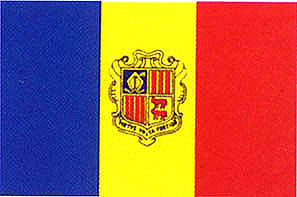
Andorra


Formal Name
Andorra,
parliamentary principality, southwestern Europe, situated in the eastern Pyrenees Mountains, bordered on the north and east by France, and on the south and west by Spain. Also called Valleys of Andorra, the country has an area of about 468 sq km (about 181 sq mi) and a population (1990 estimate) of 54,507. The overall population density in 1990 was about 117 persons per sq km (about 301 per sq mi). The capital is Andorra la Vella (population, 1990 estimate, 20,437).Land and Resources
Andorra is a region of narrow valleys and mountain peaks that reach heights of more than 2700 m (about 8860 ft). The principal stream is the Valira River. The land has iron and lead deposits and marble quarries; forests of pine and birch are found on the mountains, and low-lying areas have pastureland where sheep are grazed. Andorra has no railroad or airport but possesses an excellent road system.
Population
The native-born inhabitants of Andorra (only about one-fourth of the entire population) are Catalan in ancestry and language; Spanish and French immigrants make up the majority of the remainder. The main religion is Roman Catholicism.
Economy
Andorra's economy was formerly based on pastoral farming and the processing of tobacco and timber. Tourism has boomed since the 1950s and now dominates the principality's economic life. Tourists are drawn by the winter ski facilities, the cool summer climate, and the availability of duty-free goods. The Andorran government collects revenue through a small number of taxes and the sale of postage stamps. Immigration and investment have been encouraged by low tax rates.
Government
For 715 years, Andorra was ruled jointly by the leader of France and Spain's Bishop of Urgel, who were acknowledged as coprinces. A general council of 28 members, headed by a first and second syndic, appointed the executive council, which was headed by a president. On March 14, 1993, Andorran voters ended their feudal system of government when they approved their first constitution, which established separate legislative, executive, and judicial branches of government. The Andorran government now makes its own feudal policy and can join international organizations. France and Spain maintain some influence but are obliged to sign all laws passed by the Andorran parliament.
History
Andorra is traditionally held to have been declared a free state by Charlemagne in the 9th century AD. In 1278 it came under the joint control of the Catalan bishop of Urgel and of the count of Foix of France; through the latter, French rights passed successively to the kings and chiefs of state of France. Andorra pays a nominal biennial tribute to France and to the bishop of Urgel. In 1970 women received the right to vote. Andorra was admitted to the United Nations in 1993.